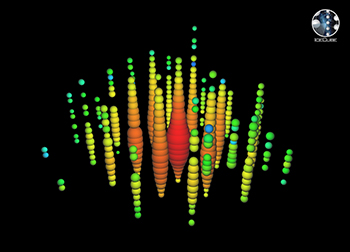
A pattern in the ice revealed the highest-energy neutrino ever detected with an estimated energy of 1.14 PeV. The dot colors indicate arrival time; the size of the dots indicate the number of photons.
A natural cube of Antarctic ice measuring 1 km3 is the perfect setting for an observatory to detect high-energy neutrinos, subatomic particles that are believed to derive from cataclysmic cosmic events like supernovas and black holes but are notoriously hard to detect. The IceCube Neutrino Observatory at the South Pole has achieved a 25-year goal of astronomers: the detection of numerous high-energy neutrino events that appear to be from interstellar space.
The IceCube observatory involves 5,160 digital optical detectors suspended along 86 strings embedded in the massive cubed kilometer of underground ice. When neutrinos interact with the ice, charged secondary particles cause tiny flashes of blue light, called Cherenkov light, which can be detected by the sensitive detectors across a wide enough area.
From 2010 to 2012, an international collaboration led by Francis Halzen, professor of physics at the University of Wisconsin-Madison, U.S.A., used IceCube to detect hundreds of thousands of the lower-energy type of “common” neutrinos coming from the sun and our atmosphere. More significantly, it identified 28 very high-energy events measuring between 30 and 1200 TeV (Science. DOI: 10.1126/science.1242856). The reported events are the most energetic particle events ever recorded, with a statistical significance of more than 4 sigma. The data cannot be explained by other types of high-energy events, such as atmospheric interactions, which qualifies them as the first evidence of neutrinos from beyond our solar system.
Neutrinos from beyond our solar system were detected once before from a supernova in 1987. The events measured by IceCube are more than a million times more powerful, according to Hazen. While the origins of the IceCube neutrinos are unknown, the energies are so high that they must derive from violent events very far away that we can’t easily see, like gamma ray bursts, neutron stars and exploding stars.
The team hopes the observations will enable a new era in astronomy. The IceCube data may help to search for dark matter, and may reveal how the mysterious neutrons are born.
